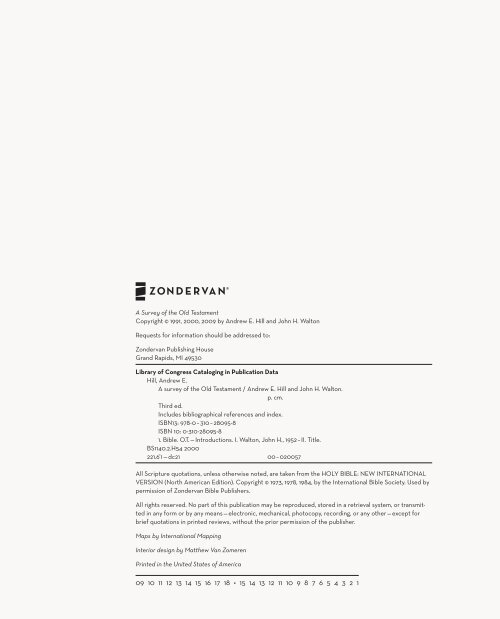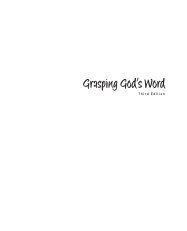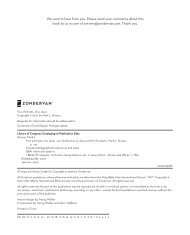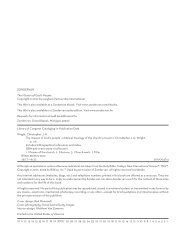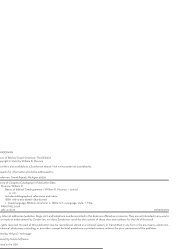A Survey of the Old Testament - Textbook Plus - Zondervan
A Survey of the Old Testament - Textbook Plus - Zondervan
A Survey of the Old Testament - Textbook Plus - Zondervan
You also want an ePaper? Increase the reach of your titles
YUMPU automatically turns print PDFs into web optimized ePapers that Google loves.
A <strong>Survey</strong> <strong>of</strong> <strong>the</strong> <strong>Old</strong> <strong>Testament</strong><br />
Copyright © 1991, 2000, 2009 by Andrew E. Hill and John H. Walton<br />
Requests for information should be addressed to:<br />
<strong>Zondervan</strong> Publishing House<br />
Grand Rapids, MI 49530<br />
Library <strong>of</strong> Congress Cataloging in Publication Data<br />
Hill, Andrew E.<br />
A survey <strong>of</strong> <strong>the</strong> <strong>Old</strong> <strong>Testament</strong> / Andrew E. Hill and John H. Walton.<br />
p. cm.<br />
Third ed.<br />
Includes bibliographical references and index.<br />
ISBN13: 978-0 – 310 – 28095-8<br />
ISBN 10: 0-310-28095-8<br />
1. Bible. O.T. — Introductions. I. Walton, John H., 1952 – II. Title.<br />
BS1140.2.H54 2000<br />
221.6’1 — dc21 00 – 020057<br />
All Scripture quotations, unless o<strong>the</strong>rwise noted, are taken from <strong>the</strong> HOLY BIBLE: NEW INTERNATIONAL<br />
VERSION (North American Edition). Copyright © 1973, 1978, 1984, by <strong>the</strong> International Bible Society. Used by<br />
permission <strong>of</strong> <strong>Zondervan</strong> Bible Publishers.<br />
All rights reserved. No part <strong>of</strong> this publication may be reproduced, stored in a retrieval system, or transmitted<br />
in any form or by any means — electronic, mechanical, photocopy, recording, or any o<strong>the</strong>r — except for<br />
brief quotations in printed reviews, without <strong>the</strong> prior permission <strong>of</strong> <strong>the</strong> publisher.<br />
Maps by International Mapping<br />
Interior design by Mat<strong>the</strong>w Van Zomeren<br />
Printed in <strong>the</strong> United States <strong>of</strong> America<br />
09 10 11 12 13 14 15 16 17 18 15 14 13 12 11 10 9 8 7 6 5 4 3 2 1
Todd Bolen/www.BiblePlaces.com<br />
CONTENTS<br />
Abbreviations 9<br />
Preface 11<br />
Image Sources 14<br />
Acknowledgments 15<br />
Using This Book 17<br />
Part I: Introduction<br />
1. Approaching <strong>the</strong> <strong>Old</strong> <strong>Testament</strong> JHW 20<br />
2. Geography <strong>of</strong> <strong>the</strong> <strong>Old</strong> <strong>Testament</strong> AEH 34<br />
Part II: The Pentateuch<br />
3. Introduction to <strong>the</strong> Pentateuch AEH 56<br />
4. Genesis JHW 76<br />
5. Exodus AEH 100<br />
6. Leviticus AEH 124<br />
7. Numbers AEH 142<br />
8. Deuteronomy JHW 162<br />
9. Historical Overview <strong>of</strong> <strong>Old</strong> <strong>Testament</strong> Times JHW 180<br />
Part III: The Historical Books<br />
10. Introduction to <strong>the</strong> Historical Books JHW 204<br />
11. Joshua JHW 216<br />
12. Judges JHW 234<br />
13. Ruth JHW 248<br />
14. 1 – 2 Sam uel JHW 256<br />
15. 1 – 2 Kings AEH 278<br />
16. 1 – 2 Chron icles AEH 308<br />
17. Ezra – Nehemiah AEH 328<br />
18. Es<strong>the</strong>r JHW 346<br />
19. Archaeology and <strong>the</strong> <strong>Old</strong> <strong>Testament</strong> 356<br />
Part IV: The Poetic Books<br />
20. Hebrew Poetic and Wisdom Literature AEH 374<br />
21. Job JHW 400<br />
22. Psalms JHW 418<br />
23. Proverbs AEH 440<br />
24. Ecclesiastes JHW 454<br />
25. Song <strong>of</strong> Songs AEH 466<br />
26. Formation <strong>of</strong> <strong>the</strong> <strong>Old</strong> <strong>Testament</strong> Scriptures 480<br />
7
8<br />
Part V: The Prophets<br />
27. Introduction to Prophetic Literature JHW 502<br />
28. Isaiah JHW 518<br />
29. Jeremiah JHW 532<br />
30. Lamentations AEH 542<br />
31. Ezekiel AEH 552<br />
32. Daniel JHW 566<br />
33. Hosea AEH 580<br />
34. Joel JHW 594<br />
35. Amos AEH 604<br />
36. Obadiah AEH 618<br />
37. Jonah JHW 628<br />
38. Micah JHW 640<br />
39. Nahum JHW 650<br />
40. Habakkuk JHW 658<br />
41. Zephaniah JHW 668<br />
42. Haggai AEH 676<br />
43. Zechariah AEH 686<br />
44. Malachi AEH 700<br />
Part VI: Epilogue<br />
45. What We Have Learned JHW 714<br />
46. Responding to God AEH 728<br />
47. The Journey to Jesus AEH 742<br />
Appendix A: Critical Methodologies 753<br />
Appendix B: The Composition <strong>of</strong> <strong>the</strong> Pentateuch 761<br />
Glossary 770<br />
Index 775
CHAPTER<br />
1<br />
Th<br />
Th<br />
Th<br />
Th<br />
Th<br />
Th<br />
Th<br />
Th<br />
Th<br />
Th<br />
Th<br />
Th<br />
Th<br />
Th<br />
Th<br />
Th<br />
Th<br />
Th<br />
T e pa<br />
pa<br />
pa<br />
pa<br />
pa<br />
pa<br />
pa<br />
pa<br />
pa<br />
pa<br />
p th<br />
th<br />
th<br />
th<br />
th<br />
th<br />
th<br />
th<br />
th<br />
th<br />
th<br />
th u<br />
u<br />
up<br />
p<br />
p Mt<br />
Mt<br />
Mt<br />
Mt<br />
Mt<br />
Mt<br />
Mt<br />
Mt<br />
Mt<br />
Mt<br />
Mt<br />
Mt.<br />
.<br />
. Si<br />
Si<br />
Si<br />
Si<br />
Si<br />
Si<br />
Si<br />
Si<br />
Si<br />
Si<br />
S na<br />
na<br />
na<br />
na<br />
na<br />
na<br />
nai.<br />
i.<br />
i.<br />
i.<br />
i.<br />
i Cop<br />
Cop<br />
Cop<br />
Co<br />
Cop<br />
Cop<br />
C p<br />
C pyri<br />
yri<br />
yri<br />
yri<br />
yri<br />
yri<br />
yri<br />
ri<br />
y ght<br />
gh<br />
ght<br />
ht<br />
ht<br />
ht<br />
ht<br />
ht<br />
ht<br />
ht<br />
ht<br />
ht<br />
ht<br />
ht<br />
ht<br />
ht<br />
ht<br />
ht<br />
ht<br />
ht<br />
ht<br />
ht<br />
ht<br />
h<br />
ght<br />
ght<br />
gh<br />
ght<br />
ht<br />
ht<br />
ht<br />
g 19<br />
19<br />
19<br />
19<br />
19<br />
19<br />
19<br />
19<br />
19<br />
19<br />
19<br />
19<br />
19<br />
19<br />
19<br />
1<br />
19<br />
19<br />
19<br />
19<br />
19<br />
95<br />
95<br />
95-<br />
95-<br />
95<br />
95-<br />
95<br />
95<br />
95<br />
95-<br />
95<br />
95<br />
95-<br />
95<br />
95<br />
95<br />
95<br />
95<br />
95<br />
95<br />
95 200<br />
200<br />
200<br />
200<br />
00<br />
00<br />
200<br />
200<br />
200<br />
0<br />
2 0<br />
200<br />
200<br />
200<br />
00<br />
009 P<br />
9P<br />
9P<br />
9P<br />
9P<br />
9 P<br />
9 P<br />
9<br />
9 P<br />
Phoe<br />
hoe<br />
hoe<br />
oe<br />
hoe<br />
hoe<br />
hoe<br />
h e<br />
h e<br />
h e<br />
h e<br />
hoe<br />
hoe<br />
oe<br />
hoenix<br />
nix<br />
nix<br />
i<br />
nix<br />
nix<br />
nix<br />
ix<br />
ni<br />
nix<br />
nix<br />
nix<br />
nix<br />
nix<br />
ni<br />
ni<br />
ni<br />
ni<br />
nix<br />
i<br />
nix<br />
nix<br />
nix<br />
nix<br />
nix<br />
ix Da<br />
Da<br />
Da<br />
Da<br />
Da<br />
Da<br />
Da<br />
Da<br />
Da<br />
Da<br />
Da<br />
Da<br />
Data<br />
ta<br />
ta<br />
ta<br />
ta<br />
ta<br />
ta<br />
ta<br />
ta<br />
t Sys<br />
Sys<br />
Sys<br />
Sys<br />
S s<br />
Sys<br />
Sy<br />
Sys<br />
ys<br />
y tem<br />
tem<br />
em<br />
tem<br />
em<br />
tem<br />
e<br />
te<br />
tem<br />
tem<br />
em<br />
e<br />
tem<br />
tem<br />
em<br />
te<br />
tem<br />
em<br />
t ms
APPROACHING<br />
THE OLD TESTAMENT<br />
Studying <strong>the</strong> <strong>Old</strong> <strong>Testament</strong> is a monumental task, but proper<br />
preparation can help <strong>the</strong> student to reap a rich harvest. The<br />
sovereign God who created <strong>the</strong> universe, who controls history,<br />
and who will accomplish his plan in his time has chosen to<br />
speak. That in itself is an act <strong>of</strong> grace, and we should feel compelled<br />
to listen. However, listening may be hindered by many complicating<br />
factors. First, God’s revelation did not come in <strong>the</strong> English<br />
language or through Western culture. As a result, we may have to<br />
work harder to receive <strong>the</strong> message clearly. The more familiar students<br />
can become with ancient Near Eastern culture, particularly<br />
that <strong>of</strong> Israel during <strong>the</strong> <strong>Old</strong> <strong>Testament</strong> period, <strong>the</strong> more barriers<br />
<strong>the</strong>y can eliminate.<br />
A second complicating factor is that even when we are listening,<br />
we have a tendency ei<strong>the</strong>r to be selective about what we hear<br />
or to try to make <strong>the</strong> message conform to what we want to hear.<br />
The solution to this is to allow <strong>the</strong> Bible to speak for itself. We all<br />
have assumptions about <strong>the</strong> Bible. These need to be constantly<br />
evaluated and refined lest <strong>the</strong>y distort <strong>the</strong> teaching <strong>of</strong> <strong>the</strong> Bible.<br />
The objectives <strong>of</strong> <strong>the</strong> biblical authors must not be subordinated to<br />
our own objectives, however worthy <strong>the</strong> latter may be. There are<br />
many valuable things to be learned from <strong>the</strong> <strong>Old</strong> <strong>Testament</strong>, but<br />
not all are things that <strong>the</strong> <strong>Old</strong> <strong>Testament</strong> is trying to teach. If students<br />
desire to reap authoritative teaching from <strong>the</strong> text, <strong>the</strong>y must<br />
learn to discern what <strong>the</strong> text is teaching ra<strong>the</strong>r than superimposing<br />
<strong>the</strong>ir own ideas on it. When <strong>the</strong> Bible is allowed to speak from<br />
its own vantage point and with its own agenda, <strong>the</strong> reader can be<br />
more open to learn what it is intending to teach.<br />
Self-Revelation<br />
As God’s self-revelation, <strong>the</strong> objective <strong>of</strong> <strong>the</strong> <strong>Old</strong> <strong>Testament</strong> is that<br />
<strong>the</strong> reader comes to know God better. This process, however, is<br />
not intended to be merely cognitive. In addition, knowing God<br />
is accomplished by experiencing his attributes. Being able to list<br />
God’s attributes is but a first step. What must be achieved is that<br />
his attributes become <strong>the</strong> framework <strong>of</strong> our worldview. By this we<br />
mean that our perspective on ourselves, our society, our world,<br />
21
22 A SURVEY OF THE OLD TESTAMENT approaching <strong>the</strong> old testament<br />
“There <strong>the</strong> angel <strong>of</strong> <strong>the</strong><br />
LORD appeared to him in<br />
flames <strong>of</strong> fire from within a<br />
bush. Moses saw that<br />
though <strong>the</strong> bush was on<br />
fire it did not burn up”<br />
(Exod. 3:2). This was a<br />
significant step in God’s<br />
program <strong>of</strong> revelation. The<br />
picture is found in <strong>the</strong><br />
Golden Hagada, an<br />
illustrated Hebrew Bible<br />
manuscript from Spain<br />
dating to AD 1320.<br />
our history, our conduct, our decisions — everything — should be knit<br />
toge<strong>the</strong>r by an informed and integrated view <strong>of</strong> God. The <strong>Old</strong> <strong>Testament</strong>’s<br />
objective is not transformed lives, though knowing God should<br />
transform one’s life. The <strong>Old</strong> <strong>Testament</strong>’s objective is not <strong>the</strong> adoption <strong>of</strong><br />
a value system, though a value system would certainly be one outcome<br />
<strong>of</strong> knowing God in a real way. The <strong>Old</strong> <strong>Testament</strong> is not a repository<br />
<strong>of</strong> historical role models, dusty hymns, and obscure prophetic sayings,<br />
but God’s invitation to hear his story.<br />
This story <strong>of</strong> God begins with creation. The emphasis, however, is<br />
not on how <strong>the</strong> world began, but on how <strong>the</strong> plan began. Everything<br />
was just right for <strong>the</strong> execution <strong>of</strong> God’s plan. In that sense, creation is<br />
simply <strong>the</strong> introduction to history. God’s sovereignty is initially assured<br />
by <strong>the</strong> fact that he created. While this cannot help but deny any claim<br />
to sovereignty by o<strong>the</strong>r deities, its intention is not to provide polemic<br />
against <strong>the</strong> pagan poly<strong>the</strong>ism <strong>of</strong> <strong>the</strong> day. Ra<strong>the</strong>r than taking a negative<br />
approach that denounces and refutes o<strong>the</strong>r deities, <strong>the</strong> <strong>Old</strong> <strong>Testament</strong><br />
takes <strong>the</strong> positive approach <strong>of</strong> telling what <strong>the</strong> one true God is like and<br />
what he has done.<br />
As history begins, it will be observed that <strong>the</strong> <strong>Old</strong> <strong>Testament</strong> is<br />
concerned with political or social aspects <strong>of</strong> history only in a secondary<br />
way. The primary interest <strong>of</strong> this history is how God has revealed<br />
himself to people in <strong>the</strong> past. One reflection <strong>of</strong> this can be found in<br />
<strong>the</strong> names <strong>of</strong> God that permeate <strong>the</strong> pages<br />
o<strong>of</strong><br />
Scripture. These names portray him as a<br />
GGod<br />
who is holy, almighty, most high, and<br />
t<strong>the</strong><br />
one who has caused everything to be.<br />
YYet<br />
he is also a God who hears, sees, and<br />
pprovides.<br />
The habitual rebellion and fee-<br />
bblemindedness<br />
<strong>of</strong> humankind shows him<br />
bby<br />
contrast a God <strong>of</strong> patience and grace.<br />
Just as creation flows into history, so<br />
hhistory<br />
flows into prophecy. God’s plan was<br />
iinitiated<br />
in <strong>the</strong> beginning, was worked out<br />
tthrough<br />
history, and will continue until<br />
aall<br />
is accomplished. By seeing God’s plan<br />
wworked<br />
out in <strong>the</strong> past (<strong>the</strong> Pentateuch and<br />
t<strong>the</strong><br />
historical books) and projected into <strong>the</strong><br />
fu future (prophetic literature), we can begin<br />
to<br />
appreciate <strong>the</strong> unfathomable wisdom <strong>of</strong><br />
GGod,<br />
who is worthy <strong>of</strong> praise and worship<br />
( (Psalms and wisdom literature). The <strong>Old</strong><br />
T<strong>Testament</strong>,<br />
<strong>the</strong>n, should be viewed as a pre-<br />
ssentation<br />
<strong>of</strong> God’s attributes in action. We<br />
ccan<br />
know who God is and what he is like<br />
Z. Radovan/www.BibleLandPictures.com
A PPROA CHING THE OLD TESTA MENT A SURVEY OF THE OLD TESTAMENT 23<br />
by hearing what he has done and intends to do. Once we know who he<br />
is and what he is like, <strong>the</strong> appropriate responses are worship, commitment,<br />
and ser vice.<br />
The Plan: God with Us<br />
What is this plan that spans <strong>the</strong> scope <strong>of</strong> creation, history, and prophecy?<br />
We find it communicated throughout <strong>the</strong> pages <strong>of</strong> <strong>the</strong> Bible.<br />
God’s plan from <strong>the</strong> beginning was to create a people among whom<br />
he could dwell and with whom he could be in relationship. We should<br />
not suppose that he needed ei<strong>the</strong>r a place to live or that he had some<br />
psychological need for companionship. His plan emerges naturally as<br />
an initiative that expresses his character as a creative, relational, and<br />
gracious being.<br />
This plan is reflected in <strong>the</strong> initial setting <strong>of</strong> Eden, where God’s<br />
presence existed in what we might call a cosmic temple, and people<br />
were placed in <strong>the</strong> garden to be near him and to have <strong>the</strong> opportunity<br />
to come to know him. The plan was upset by <strong>the</strong> disobedience<br />
that we call <strong>the</strong> fall, by which sin entered <strong>the</strong> picture. Consequently,<br />
relationship with God was disrupted and <strong>the</strong> privilege <strong>of</strong> being in<br />
<strong>the</strong> presence <strong>of</strong> God was forfeited as <strong>the</strong> first couple was driven out<br />
<strong>of</strong> <strong>the</strong> garden.<br />
The rest <strong>of</strong> <strong>the</strong> Bible is <strong>the</strong> account <strong>of</strong> God’s program to restore his<br />
presence to his people and provide means for <strong>the</strong>m to be able to be in<br />
relationship with him again. We can <strong>of</strong>fer a brief overview by identifying<br />
<strong>the</strong> seven stages <strong>of</strong> God’s presence.<br />
Stages <strong>of</strong> God’s Presence<br />
1. Eden<br />
2. Covenant<br />
3. Exodus (Bush/Sinai)<br />
4. Tabernacle/Temple<br />
5. Incarnation (Immanuel)<br />
6. Pentecost<br />
7. New Creation<br />
In <strong>the</strong> account <strong>of</strong> <strong>the</strong> Tower <strong>of</strong> Babel (Gen. 11:1 – 9) we find <strong>the</strong><br />
people undertaking a project that endeavored to reestablish God’s<br />
presence on earth. The tower was provided as a means for God to<br />
come down and take up his residence in <strong>the</strong>ir city and be worshiped.<br />
Unfortunately, <strong>the</strong>ir concept <strong>of</strong> God was flawed and when God came<br />
down, he was not pleased with <strong>the</strong> underlying premise <strong>of</strong> this initiative.<br />
His own initiative is introduced in <strong>the</strong> next chapter <strong>of</strong> Genesis<br />
as he begins to form a covenant with Abram as a means by which he
24 A SURVEY OF THE OLD TESTAMENT approaching <strong>the</strong> old testament<br />
can reveal himself to <strong>the</strong> world (explained in <strong>the</strong> next section). He<br />
chooses one family with whom he develops a relationship and among<br />
whom he will come to dwell. This second stage is <strong>the</strong> first step <strong>of</strong> <strong>the</strong><br />
reclamation project.<br />
God’s presence reaches a new level as he appears in <strong>the</strong> burning<br />
bush to Moses and reveals his name (= his character/nature) and <strong>the</strong><br />
next step <strong>of</strong> his plan. His presence is made known through <strong>the</strong> plagues,<br />
evident temporarily in <strong>the</strong> pillar <strong>of</strong> cloud and fire, and settles on <strong>the</strong><br />
top <strong>of</strong> Mt. Sinai, where he reveals how his people can be in relationship<br />
with him (<strong>the</strong> law) and how <strong>the</strong>y can preserve his presence (<strong>the</strong> rituals<br />
and o<strong>the</strong>r instructions regarding <strong>the</strong> tabernacle).<br />
In <strong>the</strong> next stage God actually initiates a means by which his presence<br />
can be established on earth. The Tabernacle is a place <strong>of</strong> God’s<br />
dwelling, and by keeping <strong>the</strong> law and observing rules <strong>of</strong> purity, <strong>the</strong><br />
people can enjoy relationship with <strong>the</strong> God who has come among <strong>the</strong>m.<br />
This stage <strong>of</strong> God’s presence is extended eventually into <strong>the</strong> Temple<br />
built by Solomon and lasts through <strong>the</strong> remainder <strong>of</strong> <strong>the</strong> <strong>Old</strong> <strong>Testament</strong>.<br />
A serious setback is suffered when <strong>the</strong> rebellion <strong>of</strong> <strong>the</strong> Israelites<br />
finally causes God’s presence to leave <strong>the</strong> temple allowing it to be<br />
destroyed (in Jeremiah and Ezekiel). The covenant benefits are lost as<br />
<strong>the</strong> Israelites are exiled from <strong>the</strong> promised land and <strong>the</strong>ir relationship<br />
with God hangs in <strong>the</strong> balance.<br />
Though <strong>the</strong>y return to <strong>the</strong> land and <strong>the</strong> temple is rebuilt, <strong>the</strong> next<br />
stage <strong>of</strong> God’s presence comes in <strong>the</strong> pages <strong>of</strong> <strong>the</strong> New <strong>Testament</strong> as<br />
God sends his Son, Jesus, to be present in human flesh (<strong>the</strong> incarnation)<br />
and take up his residence with us (Immanuel, God with us) as<br />
sort <strong>of</strong> a human tabernacle (John 1:14). It is through Christ that God’s<br />
presence thus becomes available in a whole new way and also through<br />
him that relationship is made available at a whole new level, with <strong>the</strong><br />
penalty <strong>of</strong> sin being paid, and a permanent mechanism for relationship<br />
being made available.<br />
Though Christ ascended to heaven after <strong>the</strong> resurrection, he had<br />
promised that his presence would not be taken from us, but that a<br />
Comforter would be sent. Thus <strong>the</strong> coming <strong>of</strong> <strong>the</strong> Holy Spirit at Pentecost<br />
marks <strong>the</strong> beginning <strong>of</strong> yet ano<strong>the</strong>r stage in <strong>the</strong> availability <strong>of</strong><br />
God’s presence, now within his people, and a relationship based on <strong>the</strong><br />
indwelling <strong>of</strong> <strong>the</strong> Holy Spirit. Consequently God’s people become <strong>the</strong><br />
location <strong>of</strong> God’s presence both individually (1 Cor. 6:19) and corporately<br />
(1 Cor. 3:16). The veil is torn that restricted access to God’s presence<br />
(Eph. 2) and relationship is available to all who seek it.<br />
The final stage is yet to come. It is described in Revelation 21:3,<br />
“Now <strong>the</strong> dwelling <strong>of</strong> God is with men, and he will live with <strong>the</strong>m.<br />
They will be his people, and God himself will be with <strong>the</strong>m and be<br />
<strong>the</strong>ir God.”
A PPROA CHING THE OLD TESTA MENT A SURVEY OF THE OLD TESTAMENT 25<br />
The Covenant<br />
At <strong>the</strong> core <strong>of</strong> this self-revelation, delineating <strong>the</strong> plan <strong>of</strong> God, is <strong>the</strong><br />
covenant. Even <strong>the</strong> English designation “<strong>Old</strong> <strong>Testament</strong>” indicates that<br />
<strong>the</strong> covenant is <strong>the</strong> core concept <strong>of</strong> this collection <strong>of</strong> books (testament<br />
= covenant). Through<br />
<strong>the</strong> covenant God both<br />
reveals what he is like and<br />
obliges himself to a particular<br />
course <strong>of</strong> action.<br />
His loyalty (Heb. h.esed )<br />
to <strong>the</strong> covenant frequently<br />
leads him to acts <strong>of</strong> grace<br />
and mercy, but justice is<br />
also built into <strong>the</strong> covenant<br />
to ensure accountability<br />
by his people.<br />
Since <strong>the</strong> covenant is<br />
<strong>the</strong> instrument used by<br />
God to effect self-revelation,<br />
<strong>the</strong> <strong>Old</strong> <strong>Testament</strong><br />
<strong>of</strong>ten appears to be <strong>the</strong><br />
history <strong>of</strong> <strong>the</strong> covenant,<br />
or <strong>of</strong> aspects <strong>of</strong> it, more<br />
than a history <strong>of</strong> Israel. So<br />
Genesis 12 – 50 is a history<br />
Z. Radovan/www.BibleLandPictures.com<br />
<strong>of</strong> <strong>the</strong> establishment <strong>of</strong> <strong>the</strong> Abrahamic covenant. Exodus – Deuteronomy<br />
is a history <strong>of</strong> <strong>the</strong> establishment <strong>of</strong> <strong>the</strong> Mosaic covenant at Sinai.<br />
Joshua is a record <strong>of</strong> God’s faithfulness to <strong>the</strong> covenant, while Judges is<br />
a record <strong>of</strong> Israel’s unfaithfulness to <strong>the</strong> covenant. The books <strong>of</strong> Samuel<br />
and Kings are a history <strong>of</strong> <strong>the</strong> covenant <strong>of</strong> kingship (<strong>the</strong> Davidic covenant).<br />
It is <strong>the</strong> covenant as God’s plan that is more in focus than <strong>the</strong><br />
people who are involved generation after generation.<br />
Several different approaches to <strong>the</strong> <strong>Old</strong> <strong>Testament</strong> are distinguished<br />
from one ano<strong>the</strong>r by <strong>the</strong> way each understands <strong>the</strong> covenant idea and<br />
<strong>the</strong> relationship <strong>of</strong> <strong>the</strong> covenants to one ano<strong>the</strong>r. Are <strong>the</strong>re many different<br />
covenants that independently govern periods <strong>of</strong> history, or are <strong>the</strong>re<br />
just one or two governing covenants that have o<strong>the</strong>r sub-covenants to<br />
<strong>of</strong>fer expansion and explanation? Is <strong>the</strong>re a single unconditional covenant<br />
that contains conditional covenants within it, or is <strong>the</strong> whole a<br />
conditional covenant?<br />
These are <strong>the</strong> questions that, answered different ways by different<br />
scholars, define <strong>the</strong> <strong>the</strong>ological controversies about <strong>the</strong> <strong>Old</strong> <strong>Testament</strong>,<br />
its relationship to <strong>the</strong> New <strong>Testament</strong>, and its relevance to us today.<br />
“Raise your staff and<br />
stretch out your hand over<br />
<strong>the</strong> sea to divide <strong>the</strong> water<br />
so that <strong>the</strong> Israelites can go<br />
through <strong>the</strong> sea on dry<br />
ground” (Exod. 14:16).<br />
Israel always looked back<br />
on this event as one in<br />
which God revealed<br />
himself through his actions<br />
<strong>of</strong> deliverance. The<br />
crossing <strong>of</strong> <strong>the</strong> Red Sea is<br />
depicted in this illustration<br />
from <strong>the</strong> Sarajevo Hagada,<br />
an illustrated Hebrew Bible<br />
manuscript from Spain in<br />
<strong>the</strong> 14th century AD.


